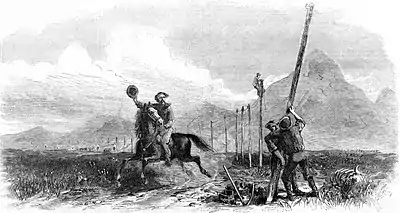Overland Telegraph Company
In 1860, the Pacific Telegraph Act of 1860 called for the facilitation of communication between the east and west coasts of the United States of America. Hiram Sibley of the Western Union Telegraph Company won the contract. In 1861, Benjamin Franklin Ficklin joined Hiram Sibley in helping to form the Pacific Telegraph Company of Nebraska. At the same time, Jeptha Wade was asked by Hiram Sibley to encourage the consolidation of telegraph companies in California, a process that had been underway there anyway, most notably involving the merger of the two largest intrastate companies following a lawsuit between them,[1] the Alta Telegraph Company and the California State Telegraph Company. The Overland Telegraph Company of California was thus formed with Horace W. Carpentier of the California State Telegraph Company serving as its president, and it began building east from Carson City, Nevada while its eastern counterpart, the Pacific Telegraph Company began building west from Omaha, Nebraska. Upon their connection in Salt Lake City, Utah on October 24, 1861, the final link between the east and west coast of the United States of America was made. The First Transcontinental Telegraph led to the immediate demise of the Pony Express. The Pacific Telegraph Company of Nebraska and the Overland Telegraph Company of California were eventually absorbed into the Western Union Telegraph Company.

James Gamble managed construction for the Overland Telegraph. Construction started on 20 June 1861 at Fort Churchill and simultaneously from Salt Lake in July. Gamble wrote, "The line was first measured and staked off; the hole-diggers followed; then came the pole-setters, and next the wire party." Between three and eight miles of line were strung per day.[2]
References
- California State Telegraph Company v. Alta Telegraph Company, 22 Cal 398 (1863)
- Bagley, Will (2014). South Pass: gateway to a continent. Norman: University of Oklahoma Press. pp. 247–248. ISBN 9780806148427.